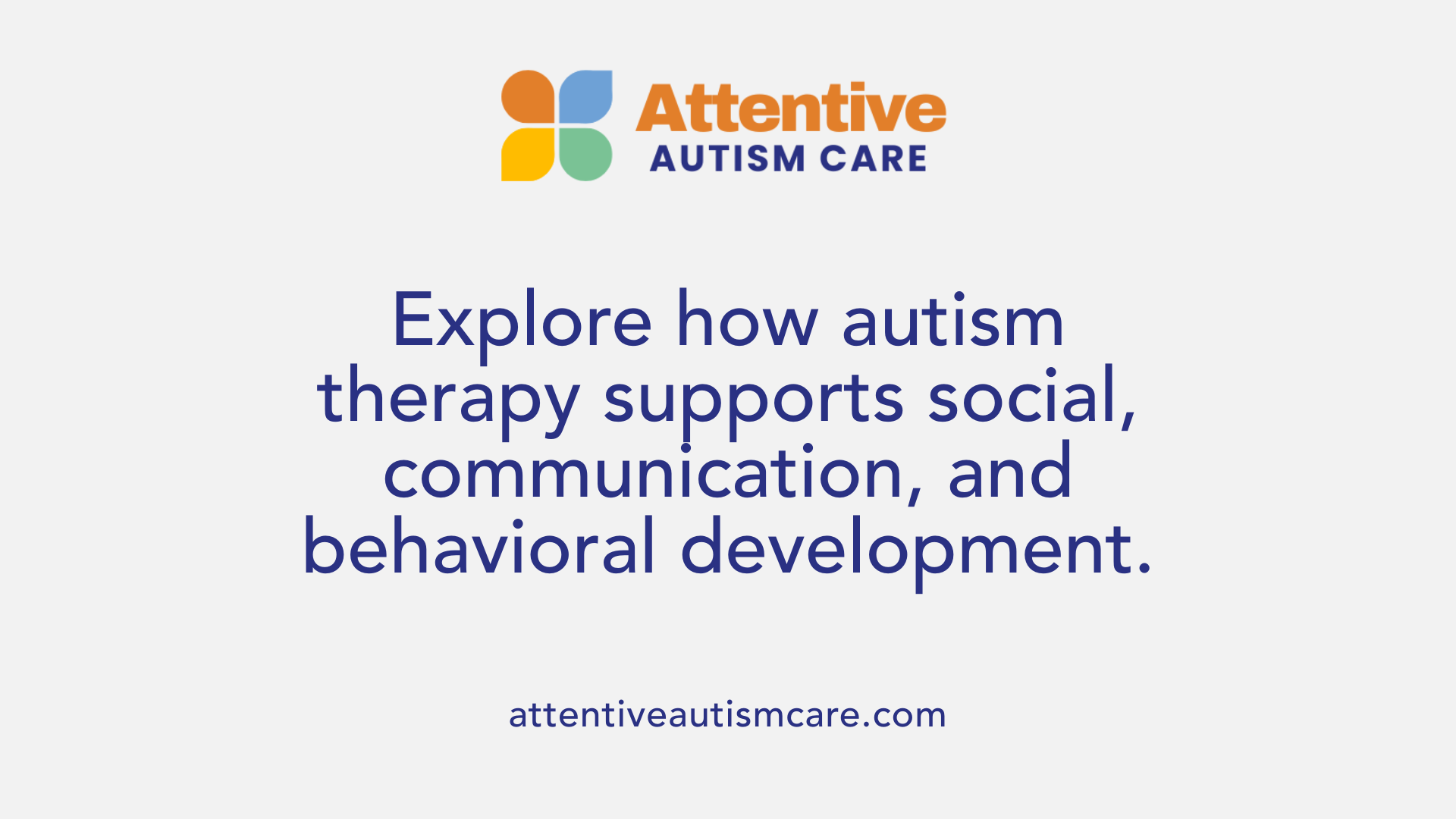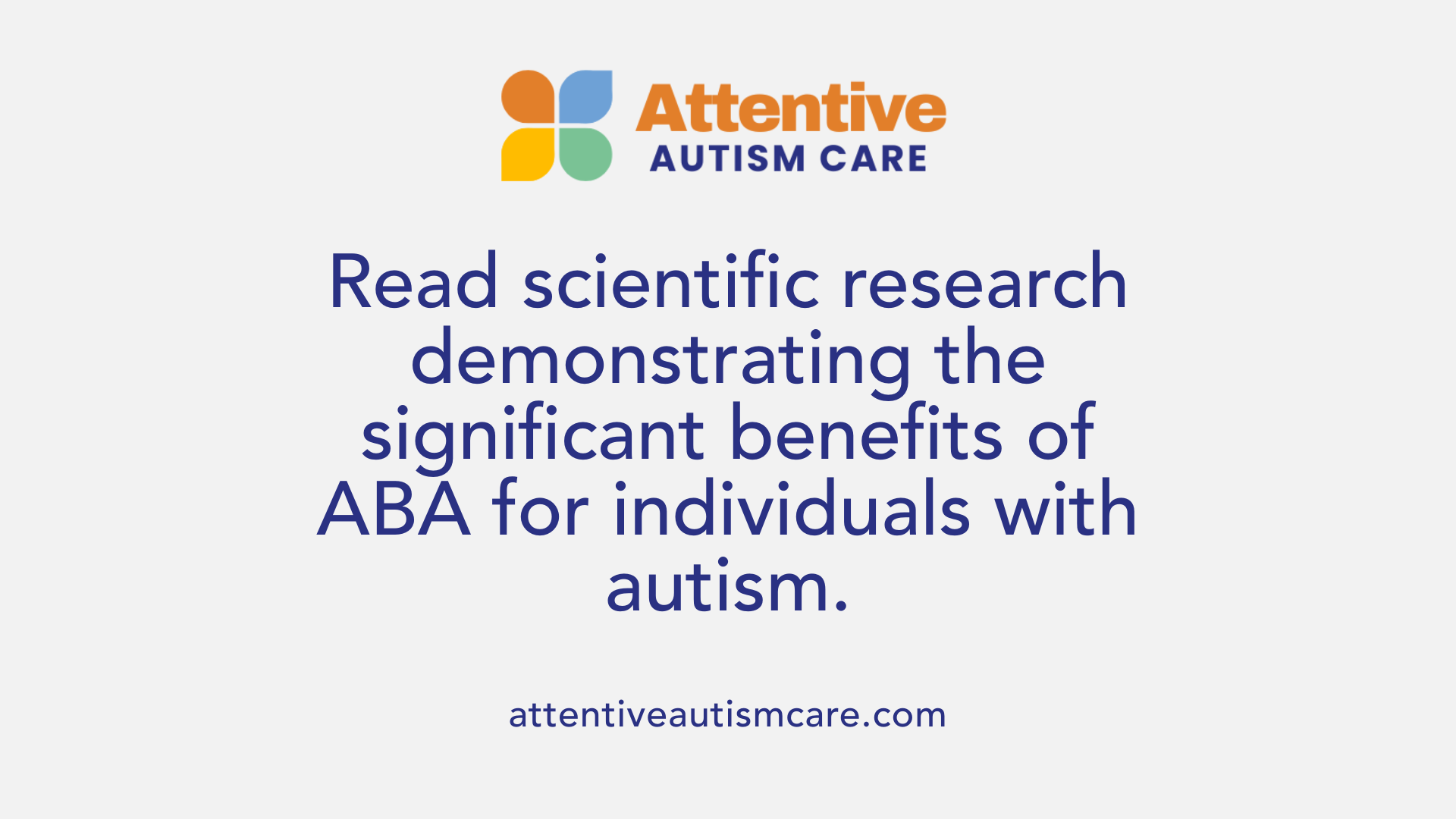Using Applied Behavior Analysis to Manage Autism Symptoms
Harnessing Behavioral Science: Transforming Lives Through ABA Therapy

Unlocking Potential with Applied Behavior Analysis
Applied Behavior Analysis (ABA) stands at the forefront of autism therapy, offering a scientifically grounded and individualized approach to help individuals with autism spectrum disorder (ASD) develop vital social, communicative, and behavioral skills. This article explores how ABA functions, its proven effectiveness, the professionals who deliver it, and how it integrates with other therapies to maximize developmental outcomes and foster meaningful social inclusion.
Understanding Autism Therapy and Its Role in Supporting Individuals with ASD

What is autism therapy and how does it help individuals with autism?
Autism therapy includes a range of evidence-based treatments designed to help individuals with autism spectrum disorder (ASD) develop vital social, communication, and behavioral skills. Among these, Applied Behavior Analysis (ABA) is one of the most established and effective approaches. ABA focuses on increasing helpful behaviors such as communication and social skills while reducing challenging behaviors through structured, positive reinforcement methods.
What are the goals and benefits of autism therapy?
The goals of autism therapy typically involve enhancing language, social interaction, daily living skills, and academic abilities. Benefits often include improved communication, better socialization, reduced problematic behaviors, and greater independence. Early and intensive intervention, especially before age four and with 20 or more hours per week, has been shown to produce significant developmental gains and reduce dependence on future special services.
What types of autism therapies are available?
In addition to ABA, speech therapy plays a key role in helping individuals improve articulation and comprehension, which supports language development. Occupational therapy addresses coordination, self-care, and sensory integration, complementing ABA by promoting skill generalization. Multidisciplinary approaches, like the Early Start Denver Model (ESDM), combine toddler-friendly play-based activities with ABA strategies to target multiple developmental goals. Psychotherapy can also be included to support emotional regulation and social challenges.
Why is individualized and early intervention important?
Autism therapies are highly personalized, tailored by qualified professionals such as Board-Certified Behavior Analysts (BCBAs) to meet each individual's unique needs. Regular data collection and ongoing assessments allow adjustments to therapy plans ensuring effectiveness. Starting therapy early in life maximizes the potential for positive outcomes and helps build a strong foundation for lifelong skills and inclusion in everyday settings.
Applied Behavior Analysis (ABA): Foundations and Principles

What is Applied Behavior Analysis (ABA) and how is it used in autism therapy?
Applied Behavior Analysis (ABA) is a therapy rooted in the science of learning and behavior. It is widely recognized as one of the most effective approaches for supporting individuals with autism spectrum disorder (ASD). ABA focuses on understanding how behavior is influenced by environmental factors and how learning takes place.
How does ABA work?
ABA therapy aims to increase positive, useful behaviors—such as communication, social skills, attention, memory, and academic abilities—while reducing harmful or non-learning behaviors. A foundational method in ABA is the ABC model, which examines Antecedents (what happens before a behavior), Behaviors themselves, and Consequences (what happens after).
Positive reinforcement plays a major role in ABA. This strategy strengthens desirable behaviors by rewarding individuals when they perform the targeted actions, encouraging those behaviors to continue.
Personalization and professional design
ABA programs are tailored to each individual's unique needs and goals. A qualified professional, usually a Board Certified Behavior Analyst (BCBA), designs and oversees these personalized programs. The goals generally cover a spectrum of skills like communication, social interaction, self-care, play, and academic development.
This individualized approach combined with ongoing data collection and progress reviews ensures that therapy is effective and responsive to the learner's progress, making ABA a flexible and adaptive treatment option for people with autism across various settings including home, school, and community.
Techniques and Methodologies Employed in ABA Therapy

What is Applied Behavior Analysis (ABA) and how is it used in autism therapy?
Applied Behavior Analysis (ABA) uses a variety of structured techniques to teach new skills and reduce challenging behaviors, particularly in children with autism spectrum disorder (ASD). ABA therapy methods are tailored to individual needs and designed to achieve meaningful social and developmental improvements.
Discrete Trial Training (DTT)
Discrete Trial Training is a highly structured ABA method involving one-on-one sessions where complex skills are broken down into small, teachable parts. Each “trial” consists of a clear instruction, the child’s response, and a consequence, often positive reinforcement. DTT emphasizes repetition and practice to foster skill acquisition.
Pivotal Response Treatment (PRT)
In contrast to DTT, PRT is more naturalistic and play-based. It encourages learning through a child’s interests and choices, using natural reinforcers like playing with favorite toys. PRT targets pivotal areas such as motivation and self-management, aiming to create widespread improvements in communication and socialization.
Early Start Denver Model (ESDM)
The ESDM is a hybrid approach combining play-based activities and traditional ABA techniques. It targets multiple developmental goals within a single activity, promoting language, cognition, and social skills in young children through engaging and interactive sessions.
Other ABA Techniques
ABA also employs methods such as:
- Modeling: Demonstrating behaviors for imitation.
- Shaping: Gradually reinforcing closer approximations of a desired behavior.
- Chaining: Teaching complex skills by linking smaller steps.
- Extinction: Reducing unwanted behavior by withholding reinforcement.
- Prompting and fading: Assisting a learner and gradually removing support.
Data Collection and Program Adjustments
Ongoing data collection is vital in ABA therapy. Therapists regularly record progress and analyze behavioral outcomes, allowing for dynamic adjustments in teaching strategies. This systematic approach ensures the therapy remains effective and responsive to individual progress.
| Technique/Methodology | Description | Therapeutic Purpose |
|---|---|---|
| Discrete Trial Training (DTT) | Structured, repetitive skill trials | Skill acquisition via clear, measurable tasks |
| Pivotal Response Treatment | Play-based, child-led intervention | Generalization of social and communicative skills |
| Early Start Denver Model | Blended play and ABA techniques | Multi-domain development for young children |
| Modeling, Shaping, Chaining | Behavioral teaching strategies | Teaching, reinforcing, and sequencing new skills |
| Data Collection | Continuous progress monitoring | Informs adjustments to optimize therapy outcomes |
These methodologies combine to make ABA therapy a comprehensive, evidence-based approach for supporting individuals with autism.
Evidence Supporting ABA’s Effectiveness in Autism Therapy

What does scientific research say about ABA outcomes?
Applied Behavior Analysis (ABA) is one of the most thoroughly studied interventions for autism spectrum disorder (ASD). Meta-analyses of multiple studies consistently show that ABA programs lead to significant gains in several developmental areas.
Which skills improve with ABA therapy?
Research findings include large improvements in:
- IQ scores (with an effect size g=0.740)
- Communication skills (g=0.650), both expressive (g=0.742) and receptive language (g=0.597)
- Socialization (g=0.444)
- Adaptive behavior (g=0.422) Smaller but positive effects are noted for daily living skills (g=0.138). These improvements contribute to better social interactions and functional independence.
Why is early and intensive ABA important?
Studies emphasize that beginning ABA therapy early, often before age 4, and maintaining an intensive schedule (20 to 40 hours per week) for one to three years yields the greatest benefits. Early intensive ABA can produce substantial developmental gains and reduce the need for future specialized services.
How does ABA therapy affect challenging behaviors and independence?
ABA targets decreasing harmful or non-learning behaviors through replacement strategies and positive reinforcement. Data-driven ongoing evaluation ensures adjustments optimize outcomes. As a result, individuals often show reduced challenging behaviors alongside increased independence in communication, self-care, social, and academic skills.
Overall, scientific evidence affirms ABA’s effectiveness as an evidence-based approach promoting meaningful, measurable improvements that enhance quality of life and social inclusion for individuals with autism.
Who Provides ABA and Autism Behavioral Services?
Who provides autism therapy and behavioral analysis services?
Autism therapy and behavioral analysis services are primarily delivered by licensed professionals trained in Applied Behavior Analysis (ABA), a scientifically supported method. The cornerstone of these services is the Board Certified Behavior Analyst (BCBA), who undergoes rigorous education, supervised practical experience, and certification to design and oversee individualized ABA programs.
Board Certified Behavior Analysts (BCBAs) and their training
BCBAs complete graduate-level coursework, such as that offered by Pepperdine University’s Master of Science in ABA, which includes both academic training and practicum experience. Afterward, candidates must pass a certification exam and maintain their credentials through ongoing education.
Role of specialized organizations and autism centers
Specialized autism centers and organizations like the Bierman Autism Center, Lighthouse Autism Center, HopeBridge, and institutes such as the Indiana ABA Institute provide comprehensive ABA services. These entities offer structured, evidence-based interventions often tailored to meet individual needs in residential, school, and community settings.
Multidisciplinary teams and caregiver involvement
ABA services frequently integrate multidisciplinary teams—including speech therapists, occupational therapists, psychologists, and social workers—to enhance treatment outcomes. Family involvement is critical; caregivers are trained to implement ABA techniques at home, enabling consistent support and skill generalization across environments.
Insurance coverage and access considerations
Coverage for ABA therapy varies by insurance provider and location, with many private insurance plans and Medicaid programs offering benefits when therapy is medically necessary. Families are encouraged to consult medical providers and insurance companies to understand eligibility and coverage details.
Together, these qualified professionals, organizations, and family members collaborate to deliver personalized, effective ABA interventions that foster meaningful improvements in communication, socialization, and independent living for individuals with autism.
Integrating ABA with Complementary Therapies for a Holistic Approach
Combining ABA with speech, occupational therapy, and psychotherapy
Applied Behavior Analysis (ABA) is most effective when integrated with other therapeutic approaches such as speech therapy, occupational therapy, and psychotherapy. Speech therapy focuses on articulation, language comprehension, and social communication, while ABA teaches the fundamentals of communication through behavior modification. Occupational therapy complements ABA by enhancing self-care skills, motor coordination, and sensory processing. Psychotherapy addresses emotional regulation, anxiety, and social interaction, supporting the socio-emotional development of individuals with autism.
Benefits of integration for communication, daily living, emotion regulation
This multidisciplinary integration promotes comprehensive development. Communication skills improve as ABA techniques build language foundations reinforced by speech therapy’s focus on expressive and receptive skills. Daily living skills become more attainable through occupational therapy’s practical training, aligned with ABA’s structured behavior shaping. Emotional regulation and social behaviors benefit harnessing psychotherapy strategies alongside ABA’s positive reinforcement and behavior analysis, leading to broader functional improvements.
Role of interdisciplinary collaboration
Successful integration relies on collaboration among behavior analysts, speech-language pathologists, occupational therapists, and psychotherapists. Together, they design coordinated goals and share progress data, ensuring consistency and complementarity of interventions. This teamwork helps tailor individualized programs that address overlapping needs and enhance the effectiveness of treatment.
Enhancing generalization of skills across settings
By combining therapies, skill generalization is promoted across home, school, and community environments. ABA’s flexible framework and data-driven adjustments allow techniques from other therapies to be incorporated naturally into daily routines. Family involvement further supports applying strategies consistently, ensuring meaningful behavior changes and greater social inclusion for children with autism.
Family Involvement and Technology in ABA Therapy
Why is caregiver training and engagement important in ABA therapy?
Family involvement is crucial in Applied Behavior Analysis (ABA) therapy because caregivers play a key role in ensuring that skills learned during sessions generalize to everyday settings. Through training, parents and caregivers learn to apply ABA techniques consistently at home and in the community, helping to reinforce positive behaviors and maintain progress. This continuous practice enhances the child's ability to transfer new skills across environments, promoting independence and social inclusion.
How does technology support and enhance ABA therapy?
Technological innovations have increasingly augmented ABA therapy through tools such as mobile applications, virtual reality (VR), and artificial intelligence (AI). Mobile apps provide personalized exercises, enabling children to practice skills interactively and engage with therapy goals beyond traditional sessions. VR creates controlled, immersive environments that simulate real-world scenarios, which helps individuals practice social and communication skills safely. AI assists therapists by analyzing progress data, customizing interventions to optimize outcomes, and tracking engagement levels.
How does technology improve consistency and skill generalization?
Technology supports consistency by offering structured and repeatable practice opportunities, while caregivers use apps and digital tools to maintain daily routines and encourage skill use. Virtual environments replicate various social settings, facilitating practice in diverse contexts which fosters generalization of learned behaviors. These tools allow for frequent and varied practice that might otherwise be difficult to implement regularly.
What role does data-driven monitoring play in ABA therapy?
Ongoing data collection is integral to ABA, enabling precise monitoring of a child’s response to interventions. Technology facilitates this through digital tracking of behaviors, session progress, and responses to reinforcement strategies. Therapists and caregivers use this data to dynamically adjust treatment plans, ensuring interventions remain effective and tailored to the individual's evolving needs. Data-driven tools make it easier to visualize trends and outcomes, making therapy more transparent and goal-oriented.
The Future of Autism Therapy: Holistic, Individualized, and Evidence-Based

ABA’s Evolution and Research Support
Applied Behavior Analysis (ABA) has firmly established itself as one of the most effective interventions for autism spectrum disorder (ASD). Since its development in the 1960s and landmark advancements in the 1980s, ABA has grown through extensive research and evidence-based practice. Meta-analyses highlight its significant positive impacts on IQ, communication, language, adaptive behavior, and socialization in individuals with ASD. These consistent outcomes over decades position ABA as a cornerstone therapy.
Customization to Individual Needs and Strengthening Social Inclusion
A defining characteristic of modern ABA therapy is its adaptability. Programs are meticulously tailored by qualified Board Certified Behavior Analysts (BCBAs) to target personal goals spanning communication, social skills, self-care, and academics. Early and intensive intervention, beginning before age four and active over multiple hours weekly, generates meaningful developmental progress and reduces the need for future services. Beyond individual skill gains, ABA plays a vital role in fostering social inclusion by enabling children to engage more fully in both educational and community settings.
Multidisciplinary and Technology-Enhanced Frameworks
Contemporary autism therapy increasingly integrates ABA with complementary disciplines like speech therapy, occupational therapy, and psychotherapy. This multidisciplinary approach addresses the broad spectrum of developmental needs including language articulation, sensory integration, and emotional regulation. Simultaneously, technology innovations such as mobile apps, virtual reality environments, and artificial intelligence tools enhance the precision, personalization, and engagement of therapy. Data-driven adjustments and family involvement further optimize outcomes and skill generalization.
Ongoing Development of Therapy Models and Positive Outcomes
ABA continues evolving through diversification of models ranging from highly structured Discrete Trial Training to naturalistic, play-based approaches like Pivotal Response Treatment and the Early Start Denver Model. These advances broaden the settings and styles of delivery to suit varied learners. Longitudinal studies confirm that sustained, comprehensive ABA programs contribute to improved functional abilities and quality of life. The field’s future outlook includes expanding accessibility, refining individualized care, and leveraging technology—all advancing the social inclusion and developmental potential for children with autism.
Maximizing Potential Through ABA Therapy
Applied Behavior Analysis represents a cornerstone in autism therapy, distinguished by its scientific foundation, individualized design, and comprehensive approach to managing autism symptoms. Supported by decades of research, ABA has proven its capacity to significantly improve communication, social, and adaptive behaviors when delivered intensively and early. When combined with complementary therapies, family involvement, and technological advancements, ABA offers a holistic framework that fosters meaningful behavior changes and promotes social inclusion. As knowledge and methods continue to evolve, ABA remains essential in unlocking developmental potential and enhancing quality of life for individuals with autism and their families.
References
- Applied Behavior Analysis (ABA)
- ABA Techniques: Strategies for Behavior Analysts - GSEP Blog
- Applied Behavior Analysis: Key Points to Improve Autism ...
- Applied Behavior Analysis (ABA)
- The effectiveness of applied behavior analysis program ...
- ABA Therapy for Autism | Benefits, Techniques & How It ...
- Applied Behavior Analysis and Communication Services



































































































